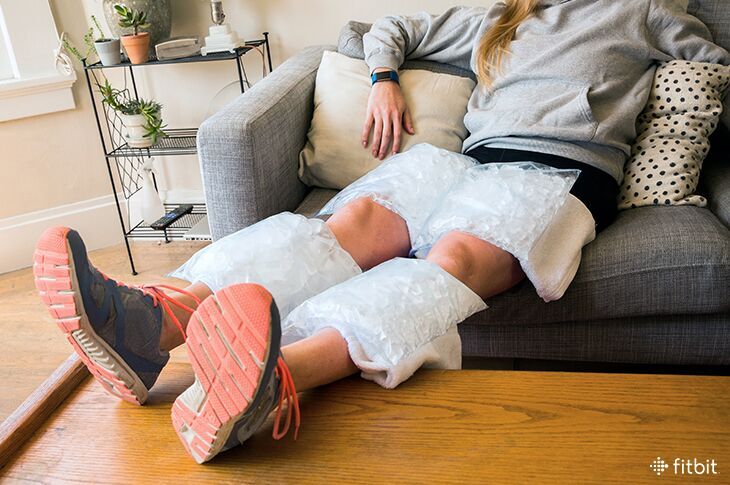 Whether you’re hurt, sore, or trying to recover faster, reaching for ice might not be the best remedy. While many athletes adopt an “ice is nice” mentality, rushing for the cold cure to reduce swelling could impede your road to recovery.
Whether you’re hurt, sore, or trying to recover faster, reaching for ice might not be the best remedy. While many athletes adopt an “ice is nice” mentality, rushing for the cold cure to reduce swelling could impede your road to recovery.
According to Gary Reinl, author of Iced: The Illusionary Treatment Option, the confusion over what to ice, when to ice, and how long to ice all boils down to one bottom line: Don’t do it. In his seven years of research on the subject, Reinl found no research showing that icing works. Instead, he discovered numerous studies, like two comprehensive surveys done in 2004 and 2008 , that conclude icing doesn’t improve recovery—and many experts agree. Even Gabe Mirkin, the sports physician who invented the common RICE (Rest, Ice, Compression, Elevation) injury protocol, now says that both ice and complete rest may delay healing.
To Ice Or Not To Ice
Before delving into the pros and cons of icing, it’s important to understand how muscle soreness works. The three stages of healing are inflammation, repair, and remodeling, says Reini.
The body automatically kicks into this immune-system process when faced with injury, including the minor injuries that result from hard workouts. The end result is that your body rebuilds stronger in order to face the stress you’re putting it under. Put simply, inflammation is essential to the process; healing doesn’t happen without it.
“People say they ice to prevent swelling,” says Reinl. “You don’t want swelling? Isn’t the purpose of swelling to bring the fluids to promote healing?” Icing, he argues, delays swelling and in the process blocks healing and recovery. “Your body was healing on its own and knew what it was doing,” he says.
That belief is shared by Ray McClanahan, DPM, a podiatrist at Northwest Foot & Ankle in Portland, Oregon. “We don’t seem to respect natural body processes,” says McClanahan. “What our body does in that acutely injured setting is actually a favorable thing. Why do we think interrupting that is a good thing? I’ve come to the conclusion that perhaps inflammation is something we want to foster, not inhibit.”
Short-Term Comfort
So, when is it OK to put the freeze on soreness? Pain relief is the one place where experts agree ice works as advertised. “The only reason to ice is to increase momentary comfort,” says McClanahan.
“If you’ve got an acute injury and you feel you need to do something, you can’t go wrong with ice,” says Ben McNair, Director of Athletic Medicine at Creighton University. That said, he recommends it far less often. “I still think ice has its uses, but less than I ever have,” he says.
Still, the verdict remains mixed. For coaches like Andrew Kastor of the Mammoth Track Club, icing still has a place in the recovery process. “I understand the physiological process and the need for inflammation, but I also know how frequently Deena [Kastor] and Meb [Keflezighi] ‘iced’ down their legs leading up to the 2004 Olympics [where both medaled],” says Kastor. “It’s hard to argue with past results.”
The Cold Takeaway
So, what should you do? When it comes to icing sore muscles, finding a strong middle ground that allows you to achieve comfort while soaking in the physiological effects could be your best solution. Take a page from elite running coach Brad Hudson, who likes alternating between hot and cold baths to enhance blood flow and recovery. His advice: On lighter work days, take a dip for three minutes in a hot bath followed by a minute in the cold.
Also remember to always listen to your body. If you need immediate pain relief from an injury, or you have to get back out there for a game or meet, icing can make you feel better. Recognize, however, that it shouldn’t be your first line of defense and could prolong recovery.
This information is for educational purposes only and is not intended as a substitute for medical diagnosis or treatment. You should not use this information to diagnose or treat a health problem or condition. Always check with your doctor before changing your diet, altering your sleep habits, taking supplements, or starting a new fitness routine.

Interesting read but maybe a bit misleading. I’ve usually heard of icing sort joints, not muscles. This article seems to link all icing together. My first thought after reading this was ‘maybe I should not be icing my sore knees after a workout.’ But on looking at the picture, it shows icing all of the leg except the knees.
That is not good ice is good
Thanks for the info. I frequently ice my injuries. I’ll try less of it now and see how that goes